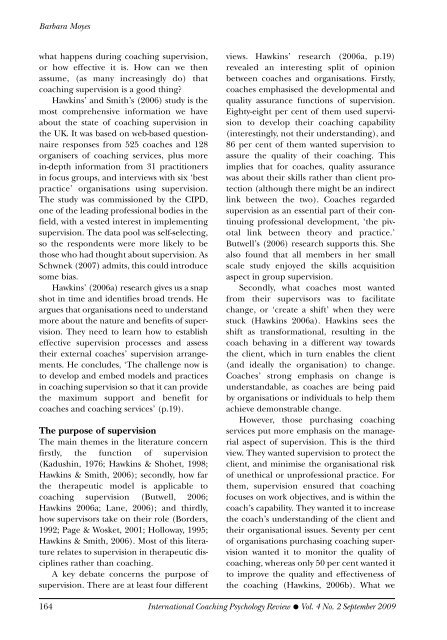International Coaching Psychology Review, 4.2, September 2009
International Coaching Psychology Review, 4.2, September 2009
International Coaching Psychology Review, 4.2, September 2009
Create successful ePaper yourself
Turn your PDF publications into a flip-book with our unique Google optimized e-Paper software.
Barbara Moyes<br />
what happens during coaching supervision,<br />
or how effective it is. How can we then<br />
assume, (as many increasingly do) that<br />
coaching supervision is a good thing?<br />
Hawkins’ and Smith’s (2006) study is the<br />
most comprehensive information we have<br />
about the state of coaching supervision in<br />
the UK. It was based on web-based questionnaire<br />
responses from 525 coaches and 128<br />
organisers of coaching services, plus more<br />
in-depth information from 31 practitioners<br />
in focus groups, and interviews with six ‘best<br />
practice’ organisations using supervision.<br />
The study was commissioned by the CIPD,<br />
one of the leading professional bodies in the<br />
field, with a vested interest in implementing<br />
supervision. The data pool was self-selecting,<br />
so the respondents were more likely to be<br />
those who had thought about supervision. As<br />
Schwnek (2007) admits, this could introduce<br />
some bias.<br />
Hawkins’ (2006a) research gives us a snap<br />
shot in time and identifies broad trends. He<br />
argues that organisations need to understand<br />
more about the nature and benefits of supervision.<br />
They need to learn how to establish<br />
effective supervision processes and assess<br />
their external coaches’ supervision arrangements.<br />
He concludes, ‘The challenge now is<br />
to develop and embed models and practices<br />
in coaching supervision so that it can provide<br />
the maximum support and benefit for<br />
coaches and coaching services’ (p.19).<br />
The purpose of supervision<br />
The main themes in the literature concern<br />
firstly, the function of supervision<br />
(Kadushin, 1976; Hawkins & Shohet, 1998;<br />
Hawkins & Smith, 2006); secondly, how far<br />
the therapeutic model is applicable to<br />
coaching supervision (Butwell, 2006;<br />
Hawkins 2006a; Lane, 2006); and thirdly,<br />
how supervisors take on their role (Borders,<br />
1992; Page & Wosket, 2001; Holloway, 1995;<br />
Hawkins & Smith, 2006). Most of this literature<br />
relates to supervision in therapeutic disciplines<br />
rather than coaching.<br />
A key debate concerns the purpose of<br />
supervision. There are at least four different<br />
views. Hawkins’ research (2006a, p.19)<br />
revealed an interesting split of opinion<br />
between coaches and organisations. Firstly,<br />
coaches emphasised the developmental and<br />
quality assurance functions of supervision.<br />
Eighty-eight per cent of them used supervision<br />
to develop their coaching capability<br />
(interestingly, not their understanding), and<br />
86 per cent of them wanted supervision to<br />
assure the quality of their coaching. This<br />
implies that for coaches, quality assurance<br />
was about their skills rather than client protection<br />
(although there might be an indirect<br />
link between the two). Coaches regarded<br />
supervision as an essential part of their continuing<br />
professional development, ‘the pivotal<br />
link between theory and practice.’<br />
Butwell’s (2006) research supports this. She<br />
also found that all members in her small<br />
scale study enjoyed the skills acquisition<br />
aspect in group supervision.<br />
Secondly, what coaches most wanted<br />
from their supervisors was to facilitate<br />
change, or ‘create a shift’ when they were<br />
stuck (Hawkins 2006a). Hawkins sees the<br />
shift as transformational, resulting in the<br />
coach behaving in a different way towards<br />
the client, which in turn enables the client<br />
(and ideally the organisation) to change.<br />
Coaches’ strong emphasis on change is<br />
understandable, as coaches are being paid<br />
by organisations or individuals to help them<br />
achieve demonstrable change.<br />
However, those purchasing coaching<br />
services put more emphasis on the managerial<br />
aspect of supervision. This is the third<br />
view. They wanted supervision to protect the<br />
client, and minimise the organisational risk<br />
of unethical or unprofessional practice. For<br />
them, supervision ensured that coaching<br />
focuses on work objectives, and is within the<br />
coach’s capability. They wanted it to increase<br />
the coach’s understanding of the client and<br />
their organisational issues. Seventy per cent<br />
of organisations purchasing coaching supervision<br />
wanted it to monitor the quality of<br />
coaching, whereas only 50 per cent wanted it<br />
to improve the quality and effectiveness of<br />
the coaching (Hawkins, 2006b). What we<br />
164 <strong>International</strong> <strong>Coaching</strong> <strong>Psychology</strong> <strong>Review</strong> ● Vol. 4 No. 2 <strong>September</strong> <strong>2009</strong>

















